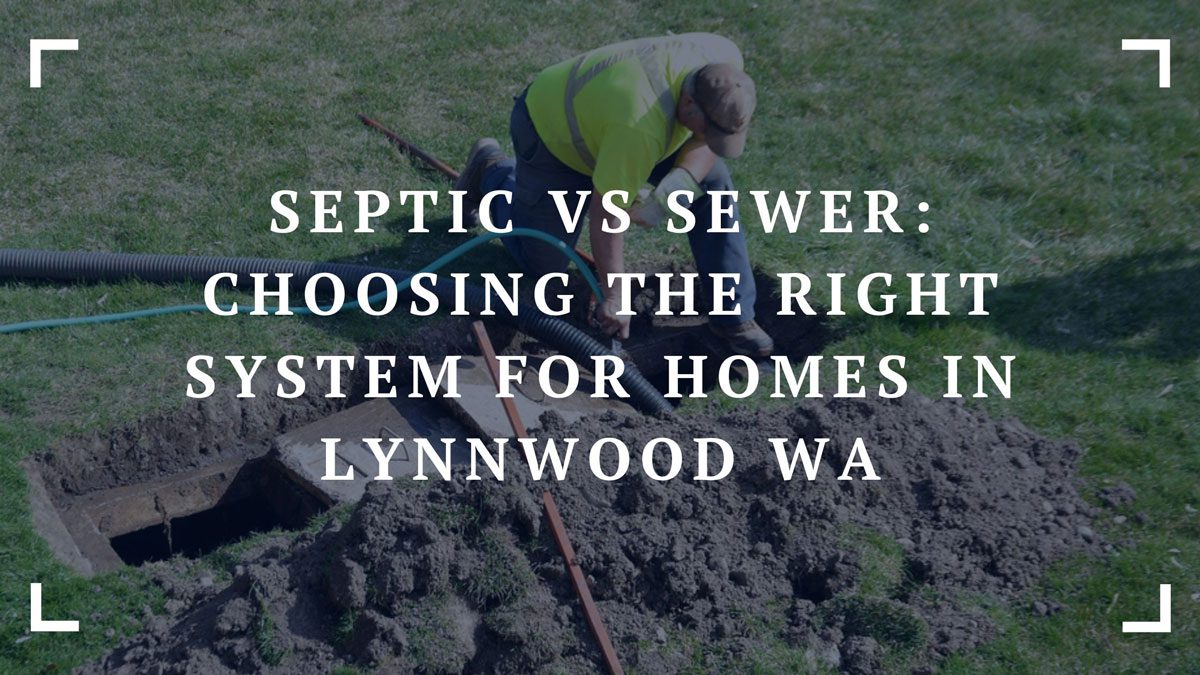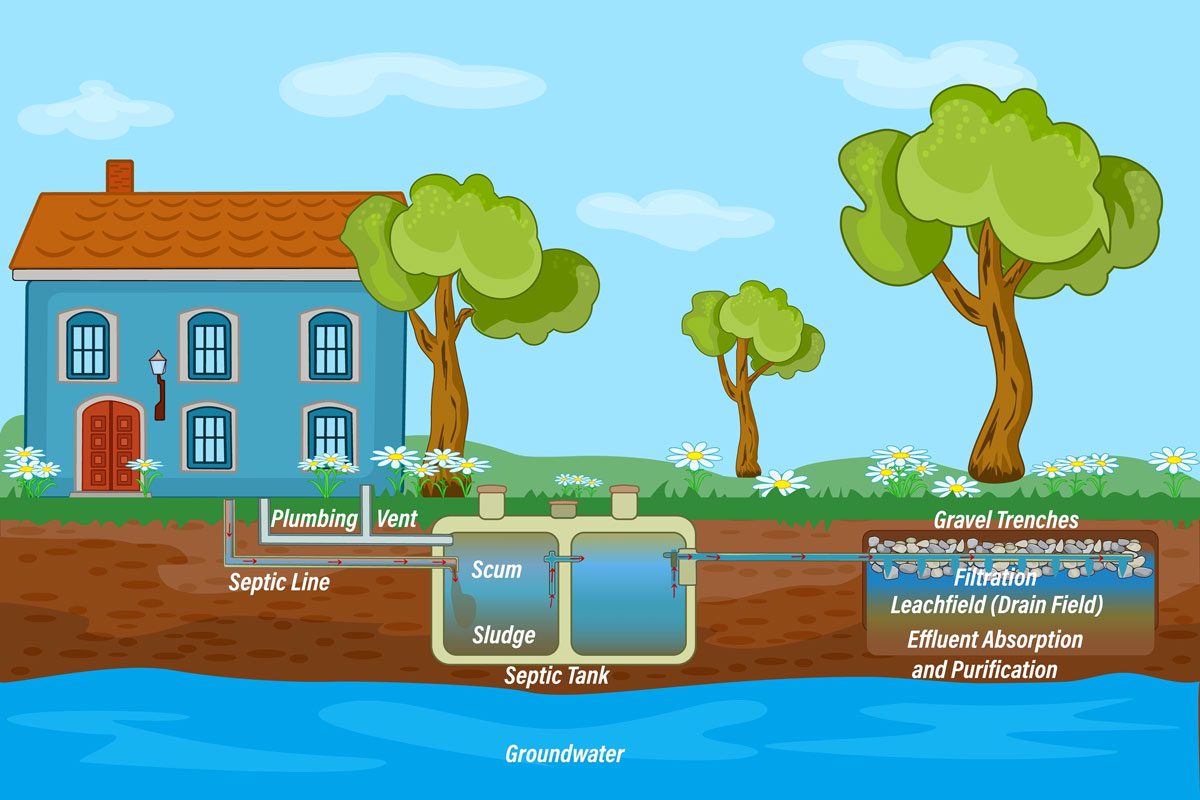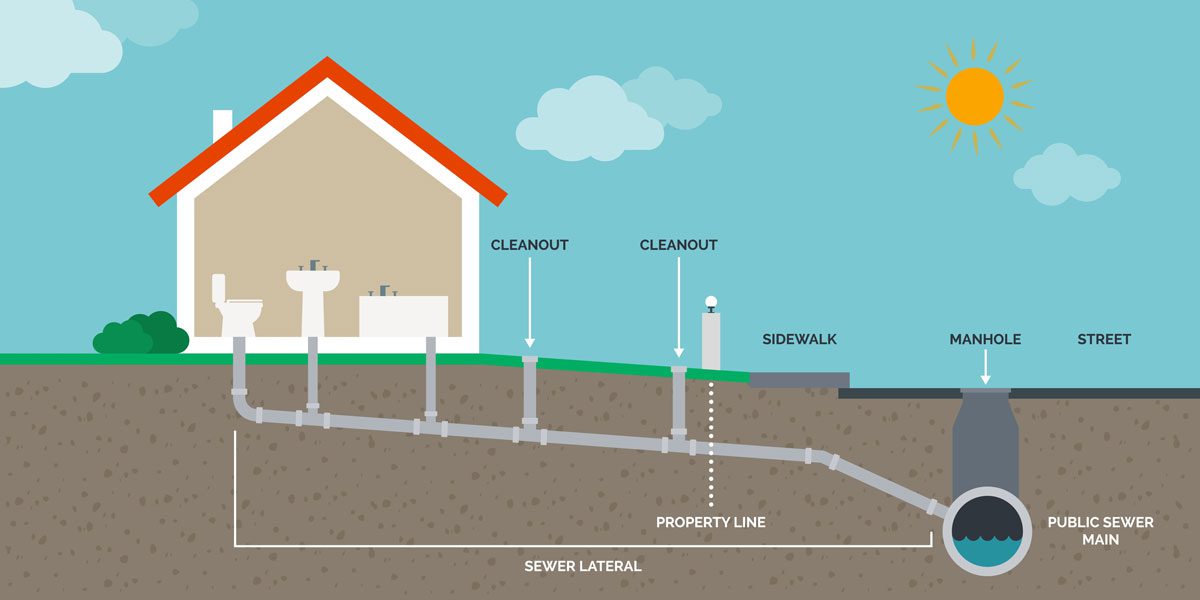Septic systems and sewer systems are two different methods of managing wastewater. Septic systems are typically used in rural areas in Lynnwood where there is no access to a public sewer system. These systems are self-contained and rely on the natural breakdown of waste in a tank buried underground. Sewer systems, on the other hand, are connected to a network of pipes that transport wastewater to a treatment plant.
Septic systems have been in use for many years and are a common sight in rural areas. They are cost-effective and require minimal maintenance, making them a popular choice for homeowners. However, septic systems can pose a risk to the environment and public health if not properly maintained. Sewer systems, on the other hand, are designed to handle large volumes of wastewater and are regulated by local authorities to ensure compliance with environmental standards.
Frank Gaborik at Danika Plumbing says the decision to use a septic system or a sewer system depends on various factors such as location, cost, and environmental impact. In this article, we will explore the differences between septic and sewer systems, their advantages and disadvantages, and the factors to consider when choosing between the two.

Basics of Septic Systems
A septic system is a self-contained wastewater treatment system that is commonly used in rural areas where there are no municipal sewer systems. It consists of three main components: the septic tank, the drain field, and the soil.
The septic tank is a large, underground container made of concrete, fiberglass, or polyethylene. It is designed to hold and treat wastewater from the home. When wastewater enters the tank, it separates into three layers: solids, liquids, and grease. The solids sink to the bottom of the tank and form a layer of sludge, while the grease floats to the top and forms a layer of scum. The liquid in the middle, known as effluent, is then discharged into the drain field for further treatment.
The drain field is a network of perforated pipes buried in trenches in the soil. The effluent from the septic tank flows into the drain field, where it is further treated and filtered by the soil. The soil acts as a natural filter, removing harmful bacteria and other contaminants from the effluent before it enters the groundwater.

Types of Septic Systems
There are two main types of septic systems: conventional and alternative. Conventional septic systems are the most common and consist of a septic tank and drain field. Alternative septic systems are used in areas where the soil is not suitable for a drain field or where there is limited space.
Some common alternative septic systems include:
- Aerobic Treatment Units (ATUs): ATUs use oxygen to break down and treat wastewater. They are typically used in areas with high water tables or poor soil conditions.
- Mound Systems: Mound systems are used in areas with shallow soil or high water tables. They consist of a sand or gravel bed that is raised above the natural soil surface.
- Drip Irrigation Systems: Drip irrigation systems use a series of small, plastic pipes to distribute effluent evenly over a large area. They are typically used in areas with limited space or poor soil conditions.
Overall, septic systems are an effective and efficient way to treat wastewater in rural areas. However, they require regular maintenance and inspection to ensure they are functioning properly and to prevent costly repairs.
Basics of Sewer Systems
Municipal sewage treatment is the process of treating wastewater from households, businesses, and industries. The treatment process involves removing impurities and contaminants from the wastewater before releasing it back into the environment. Sewage treatment plants use a combination of physical, chemical, and biological processes to treat wastewater.
Municipal Sewage Treatment
The treatment process begins with the removal of large debris and grit from the wastewater. This is followed by primary treatment, which involves the settling of solids and the removal of floating materials. Secondary treatment involves the use of biological processes to remove dissolved and suspended organic matter. Finally, tertiary treatment is used to remove any remaining contaminants before the treated wastewater is discharged into a nearby water body.
Sewer System Infrastructure
Sewer systems are the infrastructure that collects and transports wastewater from homes, businesses, and industries to the sewage treatment plant. Sewer systems consist of a network of pipes, pumps, and lift stations that transport wastewater through gravity and pressure systems.
Gravity systems use the natural slope of the land to transport wastewater to the treatment plant. Pressure systems use pumps and lift stations to transport wastewater in areas where the natural slope is insufficient. Sewer systems are typically owned and operated by local governments or utility companies.
In summary, sewer systems are an essential part of modern infrastructure that ensures the safe and efficient disposal of wastewater. Sewage treatment plants play a crucial role in protecting public health and the environment by treating wastewater before it is released back into the environment.
Comparing Septic and Sewer
When it comes to cost, septic systems and sewer systems have different implications. Septic systems are generally less expensive to install, but they do require more maintenance over time. On the other hand, sewer systems are more expensive to install, but they require less maintenance over time.
Cost Implications
The cost of installing a septic system can vary depending on the size of the system, the type of soil in the area, and the location of the property. Typically, the cost of installing a septic system can range from $3,000 to $7,000.
Sewer systems, on the other hand, can cost anywhere from $10,000 to $50,000 or more to install. However, once the system is installed, homeowners typically pay a monthly fee for the use of the system, which can range from $50 to $150 or more per month.
Environmental Impact
Another important factor to consider when comparing septic and sewer systems is their environmental impact. Septic systems can hurt the environment if they are not properly maintained. If a septic system is not maintained, it can leak harmful chemicals and bacteria into the soil and groundwater.
Sewer systems, on the other hand, can harm the environment if they are not properly maintained. If a sewer system is not properly maintained, it can leak raw sewage into the environment, which can contaminate water sources and harm wildlife.
Maintenance Responsibilities
Finally, it is important to consider the maintenance responsibilities associated with septic and sewer systems. Homeowners are responsible for maintaining their septic systems, which includes regular pumping and inspections. If a septic system fails, the homeowner is responsible for repairing or replacing the system.
Sewer systems, on the other hand, are typically maintained by the local government or utility company. Homeowners are responsible for maintaining the connection between their home and the sewer system, but the government or utility company is responsible for maintaining the main sewer line and treatment facilities.
In conclusion, when deciding between a septic system and a sewer system, it is important to consider the cost implications, environmental impact, and maintenance responsibilities associated with each option. Homeowners should carefully weigh these factors before making a decision.
Advantages of Septic Systems
Septic systems are a popular choice for homeowners who live in rural areas or areas where public sewer systems are not available. Here are some advantages of septic systems:
- Cost-effective: Septic systems are generally less expensive to install than connecting to a public sewer system. They also require less maintenance and repair over time, which can save homeowners money in the long run.
- Environmentally friendly: Septic systems are designed to treat wastewater on-site, which means that they do not contribute to the pollution of nearby bodies of water. They also use natural processes to break down and treat wastewater, which is better for the environment than the chemical treatments used in some public sewer systems.
- Independence: With a septic system, homeowners are not dependent on a public sewer system. This means that they are not subject to any restrictions or regulations that may be imposed by the local government or utility company.
- Flexibility: Septic systems can be designed to meet the specific needs of each home. This means that homeowners can choose the size and type of system that best fits their needs and budget.
In summary, septic systems offer a cost-effective, environmentally friendly, independent, and flexible solution for homeowners who need to treat their wastewater on-site.
Advantages of Sewer Systems
Sewer systems have several advantages over septic systems. Here are a few of the benefits of using a sewer system:
- Convenience: Sewer systems are much more convenient than septic systems because they do not require regular maintenance. Once a sewer system is installed, it can be used without any further attention.
- Reliability: Sewer systems are more reliable than septic systems because they are designed to handle large volumes of waste. This means that they are less likely to overflow or fail.
- Environmental Impact: Sewer systems are better for the environment than septic systems because they treat waste before it is released into the environment. This means that they are less likely to contaminate groundwater or surface water.
- Cost: While the initial cost of installing a sewer system can be higher than that of a septic system, over time, sewer systems are often more cost-effective. This is because they require less maintenance and are less likely to fail.
Overall, sewer systems are a convenient, reliable, environmentally friendly, and cost-effective way to manage waste.
Considerations for Homeowners
When deciding between a septic system and a sewer connection, homeowners should consider the size and location of their property. For properties located in rural areas, a septic system may be the only option available. Septic systems require a large area of land to install, and the soil must be suitable for absorption. Therefore, smaller properties may not be able to accommodate a septic system.
Property Size and Location
On the other hand, properties located in urban areas may have access to a sewer connection. Sewer connections are more convenient for homeowners since they do not require maintenance, and the city is responsible for repairs. However, homeowners should be aware that sewer connections may come with higher fees and taxes.
Long-Term Planning
Homeowners should also consider their long-term plans when choosing between a septic system and a sewer connection. Septic systems typically last for 20-30 years with proper maintenance, while sewer connections can last for decades or even centuries. Therefore, homeowners who plan to stay in their homes for a long time may prefer a sewer connection for its longevity.
However, if a homeowner plans to sell their property in the near future, a septic system may be a better option. A well-maintained septic system can increase the value of a property, and it may be easier to sell a property with a septic system in a rural area. Additionally, homeowners should be aware that converting from a septic system to a sewer connection can be expensive and time-consuming.
In conclusion, homeowners should carefully consider the size and location of their property, as well as their long-term plans when deciding between a septic system and a sewer connection. Both options have their advantages and disadvantages, and homeowners should choose the option that best fits their needs and budget.
Regulations and Compliance
Septic systems are regulated by local health departments and must comply with state and federal regulations. The regulations vary depending on the location and the size of the septic system. In general, septic systems must be installed and maintained by licensed professionals and must be inspected regularly to ensure they are functioning properly.
Septic Regulations
The regulations also dictate the size and type of septic system that can be installed on a property. For example, if the property is located in an area with a high water table or poor soil conditions, a specialized septic system may be required.
Sewer Connection Requirements
Sewer systems are regulated by local municipalities and must comply with state and federal regulations. In general, properties located within a certain distance of a sewer line are required to connect to the sewer system.
The requirements for sewer connections vary depending on the location and the size of the property. In some cases, the property owner may be required to pay a connection fee and install a sewer lateral to connect to the main sewer line.
It is important for property owners to understand the regulations and compliance requirements for both septic and sewer systems in their area to ensure they are in compliance and avoid any potential fines or penalties.
Installation and Conversion
When it comes to installing a septic system, it is important to first determine the appropriate location for the tank and drain field. This is typically done by a licensed professional who will take into account factors such as soil type, water table, and distance from the home.
The installation process itself involves excavating the area, installing the tank and drain field components, and backfilling the area. The entire process can take several days to complete and may require permits and inspections from local authorities.
It is important to note that the cost of installing a septic system can vary greatly depending on factors such as location, soil type, and size of the system. Homeowners should also be prepared for ongoing maintenance costs, such as regular pumping and inspections.
Connecting to a Sewer Line
Connecting a home to a sewer line typically involves excavating a trench from the home to the nearest sewer line and installing a sewer lateral. This is typically done by a licensed professional and may require permits and inspections from local authorities.
The cost of connecting to a sewer line can vary greatly depending on factors such as distance from the home to the sewer line, soil type, and any obstacles that may need to be excavated around. Homeowners should also be prepared for ongoing costs such as monthly sewer fees.
It is important to note that in some areas, connecting to a sewer line may not be an option due to a lack of infrastructure or distance from the nearest line. In these cases, a septic system may be the only viable option for wastewater treatment.
Troubleshooting Common Issues
Septic systems are designed to last for many years, but they can fail due to various reasons.
Septic System Failures
- Lack of maintenance: Neglecting to have the septic system pumped regularly can cause the tank to fill up and overflow, leading to system failure.
- Tree roots: Tree roots can grow into the septic system and cause blockages, leading to backups and system failure.
- Improper installation: If the septic system was not installed correctly, it can cause problems such as leaks, clogs, and backups.
- Overuse of the system: Using too much water or flushing non-biodegradable items down the toilet can cause the system to fail.
If you suspect that your septic system has failed, there are several signs to look out for, including:
- Foul odors: If you notice a strong sewage smell coming from your yard or home, it could be a sign that your septic system has failed.
- Slow drains: If your sinks, toilets, or showers are draining slowly, it could be a sign of a blockage in your septic system.
- Wet spots: If you notice wet spots or standing water in your yard, it could be a sign that your septic system is overflowing.
Sewer Backups and Blockages

Sewer backups and blockages can be caused by a variety of factors, including:
- Flushing non-biodegradable items down the toilet: Items such as wipes, feminine hygiene products, and paper towels can cause blockages in the sewer system.
- Tree roots: Tree roots can grow into the sewer pipes and cause blockages.
- Grease buildup: Pouring grease down the drain can cause it to build up in the pipes and cause blockages.
If you experience a sewer backup or blockage, there are several steps you can take to troubleshoot the issue:
- Check the other drains in your home: If only one drain is backed up, it could be a localized issue. If multiple drains are backed up, it could be a larger issue with the sewer system.
- Try using a plunger: A plunger can often dislodge minor blockages in the pipes.
- Call a professional: If you are unable to resolve the issue on your own, it is best to call a professional plumber or sewer technician to diagnose and fix the problem.
By understanding the common issues that can arise with septic and sewer systems, you can take steps to prevent problems and troubleshoot issues as they arise.
Future Trends in Waste Management
As society becomes more environmentally conscious, there is a growing interest in finding alternative waste management solutions. One such solution that is gaining popularity is the use of decentralized wastewater treatment systems, which include septic systems.
Septic systems are often viewed as a more sustainable option for waste management, as they rely on natural processes to treat and dispose of wastewater. They also offer greater flexibility in terms of placement and can be used in areas where traditional sewer systems are not feasible.
Another trend in waste management is the use of advanced technologies to improve the efficiency and effectiveness of sewer systems. For example, some cities are implementing smart sewer systems that use sensors and data analytics to monitor and optimize the flow of wastewater.
There is also a growing interest in using recycled wastewater for non-potable purposes, such as irrigation and industrial processes. This not only reduces the demand for freshwater but also reduces the amount of wastewater that needs to be treated and disposed of.
Overall, the future of waste management is likely to involve a combination of decentralized and centralized systems, as well as a greater focus on sustainable and innovative solutions.


